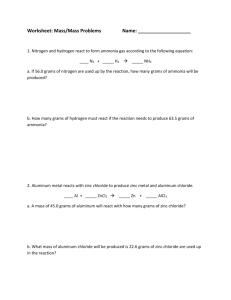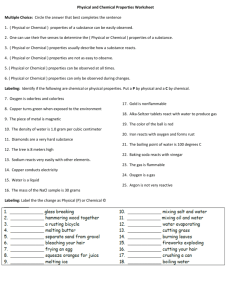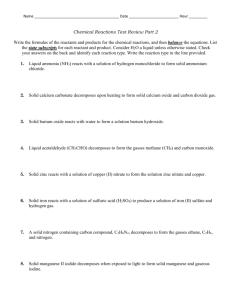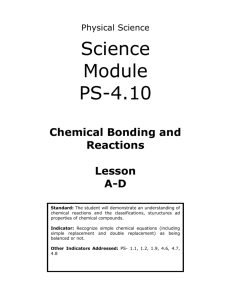Stoichiometry Study Guide & Review
advertisement
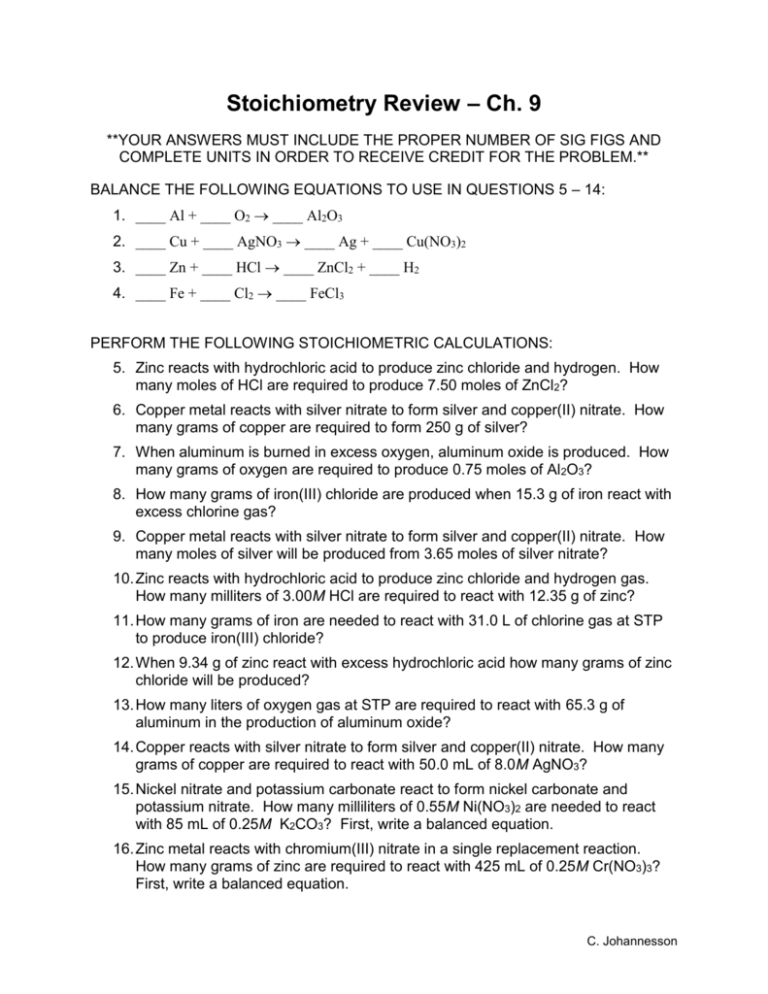
Stoichiometry Review – Ch. 9 **YOUR ANSWERS MUST INCLUDE THE PROPER NUMBER OF SIG FIGS AND COMPLETE UNITS IN ORDER TO RECEIVE CREDIT FOR THE PROBLEM.** BALANCE THE FOLLOWING EQUATIONS TO USE IN QUESTIONS 5 – 14: 1. ____ Al + ____ O2 ____ Al2O3 2. ____ Cu + ____ AgNO3 ____ Ag + ____ Cu(NO3)2 3. ____ Zn + ____ HCl ____ ZnCl2 + ____ H2 4. ____ Fe + ____ Cl2 ____ FeCl3 PERFORM THE FOLLOWING STOICHIOMETRIC CALCULATIONS: 5. Zinc reacts with hydrochloric acid to produce zinc chloride and hydrogen. How many moles of HCl are required to produce 7.50 moles of ZnCl2? 6. Copper metal reacts with silver nitrate to form silver and copper(II) nitrate. How many grams of copper are required to form 250 g of silver? 7. When aluminum is burned in excess oxygen, aluminum oxide is produced. How many grams of oxygen are required to produce 0.75 moles of Al2O3? 8. How many grams of iron(III) chloride are produced when 15.3 g of iron react with excess chlorine gas? 9. Copper metal reacts with silver nitrate to form silver and copper(II) nitrate. How many moles of silver will be produced from 3.65 moles of silver nitrate? 10. Zinc reacts with hydrochloric acid to produce zinc chloride and hydrogen gas. How many milliters of 3.00M HCl are required to react with 12.35 g of zinc? 11. How many grams of iron are needed to react with 31.0 L of chlorine gas at STP to produce iron(III) chloride? 12. When 9.34 g of zinc react with excess hydrochloric acid how many grams of zinc chloride will be produced? 13. How many liters of oxygen gas at STP are required to react with 65.3 g of aluminum in the production of aluminum oxide? 14. Copper reacts with silver nitrate to form silver and copper(II) nitrate. How many grams of copper are required to react with 50.0 mL of 8.0M AgNO3? 15. Nickel nitrate and potassium carbonate react to form nickel carbonate and potassium nitrate. How many milliliters of 0.55M Ni(NO3)2 are needed to react with 85 mL of 0.25M K2CO3? First, write a balanced equation. 16. Zinc metal reacts with chromium(III) nitrate in a single replacement reaction. How many grams of zinc are required to react with 425 mL of 0.25M Cr(NO3)3? First, write a balanced equation. C. Johannesson PERFORM THE FOLLOWING LIMITING REACTANT PROBLEMS: 17. When 16.3 g of magnesium and 4.52 g of oxygen gas react, how many grams of magnesium oxide will be formed? Identify the limiting and excess reactants. 2 Mg + O2 2 MgO 18. If 25.3 g of aluminum reacts with 25.3 g of copper(II) sulfate, how many grams of copper are formed? Identify the limiting and excess reactants in this single replacement reaction. 2 Al + 3 CuSO4 3 Cu + Al2(SO4)3 19. Identify the limiting and excess reactants when 1.00 g of zinc reacts with 150 mL of 0.250M Pb(NO3)2. How many grams of lead are formed in this single replacement reaction? Zn + Pb(NO3)2 Pb + Zn(NO3)2 20. If 24.5 g of iron are placed in 1.00 L of 0.25M HCl, how many grams of FeCl2 are obtained? Identify the limiting and excess reactants in this single replacement reaction. Fe + 2 HCl FeCl2 + H2 PERFORM THE FOLLOWING PERCENT YIELD CALCULATIONS: 21. If 12.5 g of copper react with excess chlorine gas, then 25.4 g of copper(II) chloride are produced. Find the theoretical and percent yields. Cu + Cl2 CuCl2 22. If 6.57 g of iron react with an excess of hydrochloric acid, HCl, then 11.2 g of iron(II) chloride are obtained in addition to hydrogen gas. Find the theoretical and percent yields. Fe + 2 HCl FeCl2 + H2 23. If 5.45 g of potassium chlorate are decomposed to form potassium chloride, 1.75 g of oxygen gas are also given off. Find the theoretical and percent yields. 2 KClO3 2 KCl + 3 O2 C. Johannesson Stoichiometry Review – Ch. 9 ANSWER KEY BALANCED EQUATIONS 1. 4 Al + 3 O2 2 Al2O3 2. Cu + 2 AgNO3 2 Ag + Cu(NO3)2 3. Zn + 2 HCl ZnCl2 + H2 4. 2 Fe + 3 Cl2 2 FeCl3 STOICHIOMETRIC CALCULATIONS 5. 15.0 mol HCl 6. 74 g Cu 7. 36 g O2 8. 44.4 g FeCl3 9. 3.65 mol Ag 10. 126 mL HCl 11. 51.5 g Fe 12. 19.5 g ZnCl2 13. 40.7 L O2 14. 13 g Cu 15. Ni(NO3)2 + K2CO3 NiCO3 + 2 KNO3, 39 mL Ni(NO3)2 16. 3 Zn + 2 Cr(NO3)3 3 Zn(NO3)2 + 2 Cr, 10. g Zn LIMITING REACTANT 17. LR: O2 XS: Mg Product: 11.4 g MgO 18. LR: CuSO4 XS: Al Product: 10.0 g Cu 19. LR: Zn XS: Pb(NO3)2 Product: 3.17 g Pb 20. LR: HCl XS: Fe Product: 16 g FeCl2 PERCENT YIELD 21. Theoretical: 26.4 g CuCl2 Percent Yield: 96.2% 22. Theoretical: 14.9 g FeCl2 Percent Yield: 75.1% 23. Theoretical: 2.13 g O2 Percent Yield: 82.2% C. Johannesson





